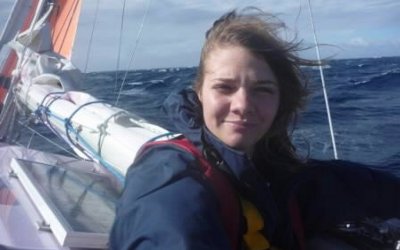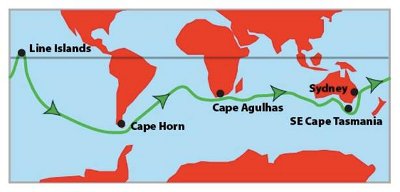Around the World in 80 (plus 129) days
by Burkard Polster and Marty Ross
The Age, 17 May 2010

After 209 straight days at sea, Jessica Watson has finally completed her trip around the world, alone and unassisted. It would be a terrific achievement for anyone, and 16-year-old Jessica is now the youngest person to have accomplished it, eclipsing the 1998-1999 effort of then 18-year-old Jesse Martin. Except, the respected website Sail-World.com is now claiming that Jessica didn't actually sail around the World!
Is Sail-World correct? In attempting to untangle this dispute, we had to consider what it actually means to sail around the world. It is a surprisingly tricky question.
Almost everyone would agree that following a (relatively) small circle around the Antarctic would be cheating. A precisely mathematical way to rule this out is to demand that the circle be as large as possible, the 21600 nautical miles for the route around the equator. (A nautical mile is about 1.8 kilometres, slightly longer than a regular mile). However, this would require Jessica to drag her yacht over large stretches of dry land, which seems a trifle unfair. There are other maximum-size circles one could try, but no such circle passes entirely through the oceans.
Anyway, it is clearly fussy and impractical to demand such a precise route. A more natural requirement, which is often suggested, is that the route finish where it begins, and that along the way the route must pass through two points on exactly opposite sides of the Earth. Such points are called antipodal, with the most famous antipodal pair being the North and South Poles (of course, a useless pair for Jessica).
A practical difficulty with this requirement is that the natural sailing routes lie low in the southern hemisphere, and all the antipodal points are located in the northern hemisphere. So, in order to pass through antipodal points, a low southern route must make a significant detour into the northern hemisphere. This is exactly the type of route Jesse Martin followed.
A map of Jessica Watson's route makes clear that, though her yacht did poke its nose across the equator, it never passed through antipodal points. So, there is a sense in which it is fair to say that Jessica did not sail around the world.

However, that is by no means the end of the story. In fact, the criticism from Sail-World has absolutely nothing to do with antipodal points.
Records for sailing "round the world" are governed by the World Speed Sailing Record Council, which has published a list of rules. To us, these rules seem quite arbitrary. For example, there is no requirement to pass through antipodal points, but the route is required to cross the equator (the reason for Jessica's northern detour). Why make people bother?
Nonetheless, the WSSRC can impose whatever rules they wish. The one rule of concern to Sail-World is:
The shortest orthodromic track of the vessel must be at least 21,600 nautical miles in length.
The 21,600 nautical miles is obviously there to ensure that the total distance traveled at least matches the length of an equatorial route. Fair enough. However, "orthodromic track" is specifying how that distance must be calculated, and it is here that things get murky.
A path between two points is called orthodromic if it is the shortest possible path connecting the points. (Note that we're staying on the surface of the water here: submarines traveling along straight lines are not permitted). But how does one use this to analyse Jessica's path?

To apply the distance rule, the reporters at Sail-World chose five land locations close to Jessica's route: Sydney, Line Island, Cape Horn,Cape Agulas, SE Cape Tasmania, and Sydney again to finish. The reporters then calculated the five orthodromic distances between adjacent points and summed these distances. They concluded that, even though Jessica's actual path exceeded 23,000 nautical miles in length, the "orthodromic track" of Jessica's route amounted to only 18,265 nautical miles, well short of the required distance.
We disagree. Even with the peculiar and confusing WSSRC rules at hand we can make no sense of Sail-World's calculations. Firstly, the land locations seem arbitrary, since they only very roughly approximate Jessica's actual path. Secondly, we can see no reason to use only five locations, and using more would significantly increase the "orthodromic track". In fact, using sufficient locations on Jessica's actual route would give an orthodromic track close to the 23,000 nautical miles that everybody agrees Jessica travelled. Finally, even if the WSSRC rules demand that the orthodromic calculation use land-based points (for heaven knows what reason), we believe that throwing in a few convenient islands near Jessica's route may raise her orthodromic track up to the required 21,600 nautical miles.
What if we're wrong, and Jessica's trip came up 3335 nautical miles short? As we read the WSSRC rules, Jessica could have made up the distance by sailing across Sydney Harbour a thousand or so times. Well, if that's what makes the difference between going "round the world" or not, who on Earth cares?
So, that is our conclusion. We believe the WSSRC rules are silly, and the complaints from Sail-World are sillier. To the extent that the requirements make any sense at all, we believe Jessica Watson has satisfied them. And, in the manner that most people seem to understand what going round the world means, we believe Jessica has in fact done so. From the Maths Masters, and clearly from many others, congratulations!
Puzzle to Ponder: Feel free to suggest solutions in the comments section. Please also email us if you wish to be added to our email list.
We have suggested above that going around the world should require passing through a pair of antipodal points. Can you think of a silly route that goes through antipodal points but does not "really" go round the world? Can you think of a rule to exclude such silly routes?
Burkard Polster teaches mathematics at Monash and is the university's resident mathemagician, mathematical juggler, origami expert, bubble-master, shoelace charmer, and Count von Count impersonator.
Marty Ross is a mathematical nomad. His hobby is smashing calculators with a hammer.
Copyright 2004-∞ ![]() All rights reserved.
All rights reserved.